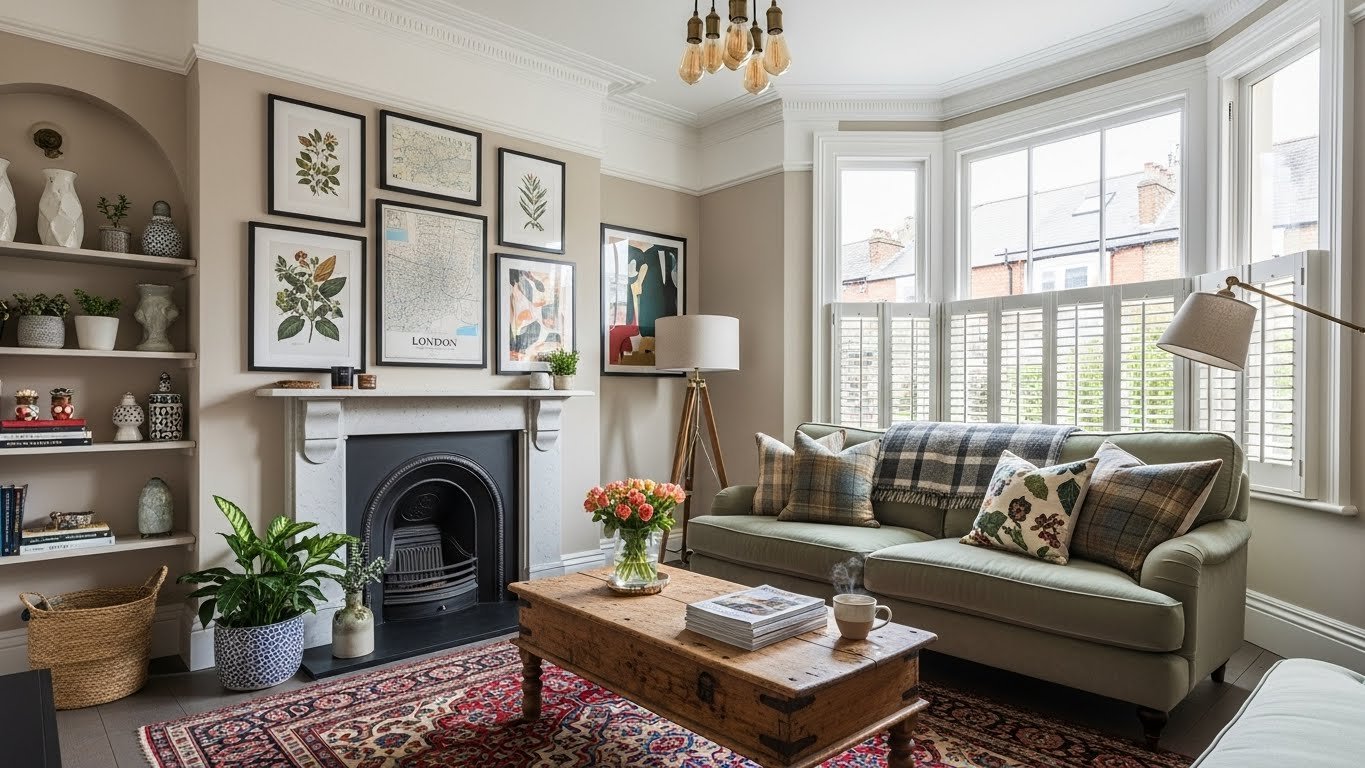Feeling cramped in your small living space? Transform your area into a lush oasis with creative DIY projects. Use wall planters and vertical gardening techniques to do this. You’ll make your home look better and feel more calm.
Use wall-mounted planters to grow herbs, succulents, and more. They’re great for small spaces. With a bit of creativity, any wall can become a green space. Discover the joy of DIY wall planters and bring nature indoors.
The Benefits of Vertical Gardening for Small Spaces
Vertical gardening is a game-changer for small spaces. It offers many benefits that can change your living area. You can create a lush, green environment that makes your home look better and healthier.
Space-Saving Advantages of Growing Upward
One big advantage of vertical gardening is saving space. Growing plants up lets you use more space, perfect for small apartments or balconies. It’s great for having a garden when you don’t have much floor space.
Environmental Benefits in Urban Settings
Vertical gardening has many environmental benefits, mainly in cities. It cleans the air, lowers urban heat, and helps local wildlife. Adding plants to your vertical garden makes your environment cleaner and more sustainable.
Mental Health and Aesthetic Improvements
Vertical gardening also boosts your mental health and makes your space look better. Being around plants can lower stress, improve mood, and bring peace. It lets you show your creativity in garden design, making your space more personal.
By using vertical gardening, you get many benefits that improve your living space and life quality.
Essential Tools and Materials for Your Vertical Garden Projects
To make a thriving vertical garden, you need the right tools and materials. This includes choosing eco-friendly options. You’ll also need the right equipment for a successful DIY project.
Must-Have Tools for DIY Garden Construction
For a vertical garden, you’ll need some basic tools. A drill is key for making holes. A level ensures everything is even. Don’t forget gardening gloves for protection.
A tape measure and pencil are also important. They help you measure and mark the wall or frame.
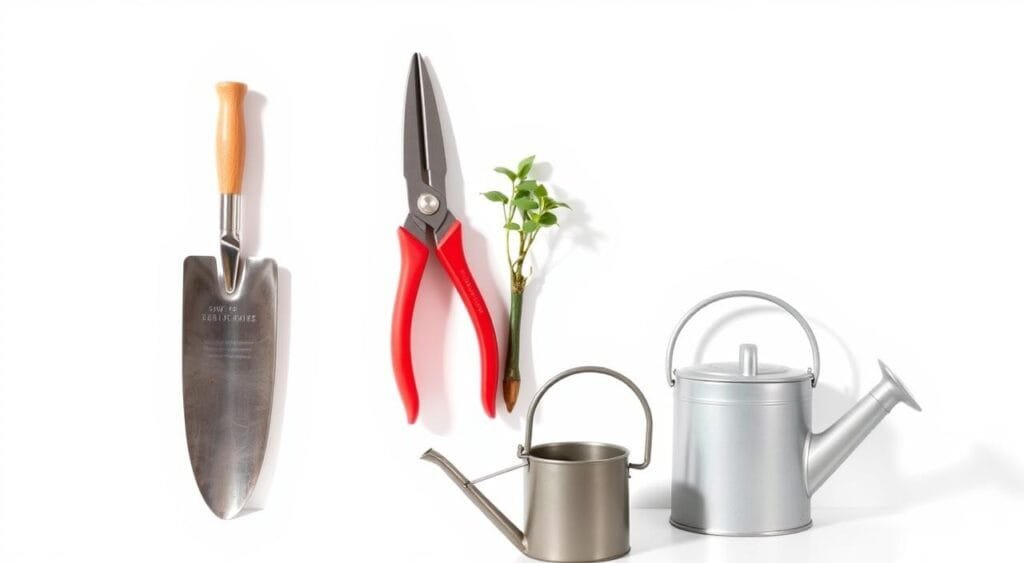
Eco-Friendly and Upcycled Material Options
Choosing eco-friendly materials makes your garden more sustainable. Consider reclaimed wood, bamboo, or recycled plastic for frames or planters. These materials reduce waste and add a unique touch.
Selecting the Right Plants for Vertical Growth
Choosing the right plants is key for a thriving vertical garden. Pick plants that grow well vertically and thrive in your conditions.
Best Trailing Plants for Hanging Systems
For hanging systems, trailing plants like English ivy, creeping Jenny, or trailing succulents are great. They cascade down, making a beautiful display.
Compact Plants for Wall Planters
Compact plants like polka dot plants, begonias, or small ferns are perfect for wall planters. They grow upright and don’t take up too much space.
Herbs and Vegetables That Thrive Vertically
For edible gardens, think about herbs like basil, mint, or parsley. Also, consider vegetables like cherry tomatoes, leafy greens, or peppers. These plants grow well vertically and can be harvested often.
Planning Your Vertical Garden: Design Considerations
When planning a vertical garden, several design factors are key. A well-planned garden looks great and improves your environment. It’s all about creating a space that’s both beautiful and healthy.
Evaluating Your Space and Light Conditions
Start by checking your space and light. Think about how much sunlight it gets. Choose plants that match your light conditions. For example, full sun plants need lots of direct sunlight.
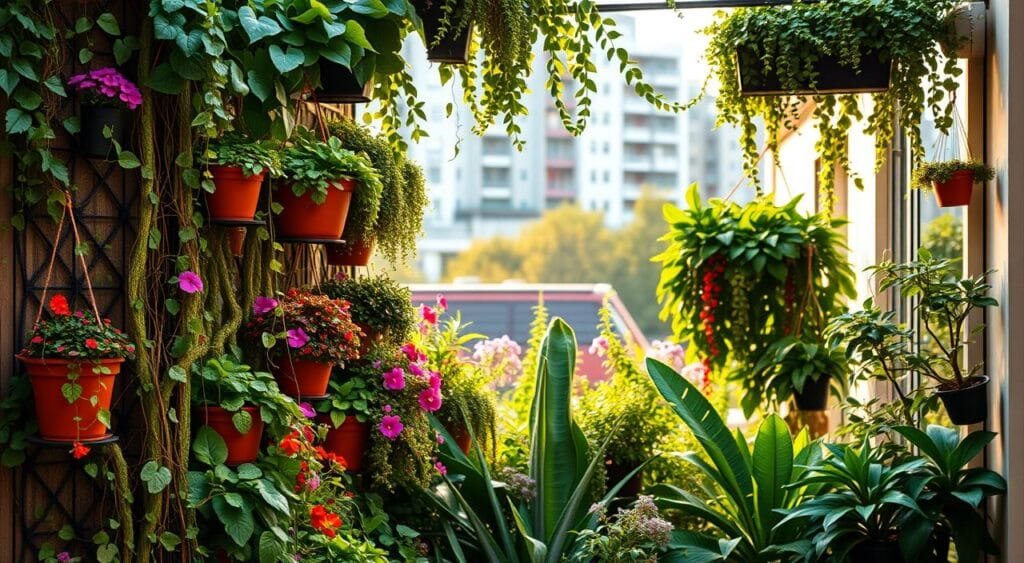
Weight Considerations and Structural Support
Don’t forget about the garden’s weight and support needs. Make sure your wall can handle the garden’s weight. Using light materials can help with this.
Creating a Functional and Beautiful Design Plan
Creating a good design is vital. Think about the layout and plant types. A mix of plants and textures makes your garden look great. Remember to leave space for plants to grow.
By evaluating your space, considering weight and support, and planning your design, you’ll have a beautiful vertical garden. It will thrive and enhance your space.
DIY Pallet Vertical Garden: Step-by-Step Guide
Creating a DIY pallet vertical garden is a great way to garden. It’s perfect for small spaces and can be made to fit your style.
Gathering Materials and Preparing Your Pallet
You’ll need a pallet, wooden planks, a hammer, nails, and a drill. Choose a pallet that’s in good shape and free from chemical treatment. Clean it well and let it dry before you start.
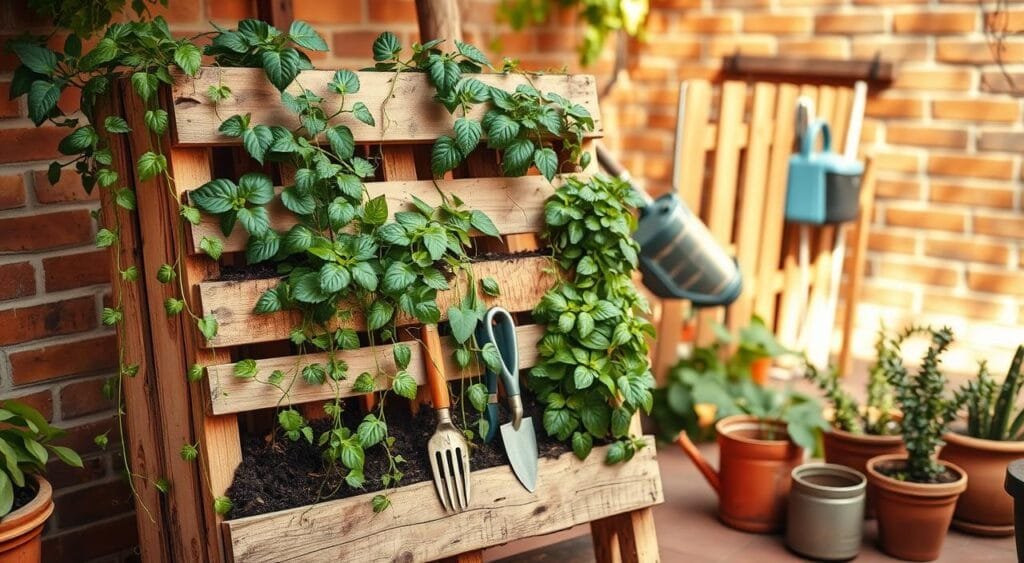
Constructing the Planting Pockets
Now, make the planting pockets. Cut the planks to the right size and attach them to the pallet. Use nails or a drill. Make sure they’re evenly spaced for your plants to grow well.
Installing Irrigation and Drainage Systems
A good irrigation system is key for your plants. You can use a drip irrigation system or soaker hose. Also, add a drainage system to avoid waterlogged soil.
Planting and Mounting Your Pallet Garden
After building your garden, it’s time to plant. Pick plants that do well in vertical gardens, like succulents or herbs. Then, hang your garden on a wall or fence, making sure it’s level and stable.
By following these steps, you can make a beautiful and useful vertical garden guide for your space.
Creative Indoor Vertical Garden Ideas for Tiny Apartments
You can turn a small apartment into a vibrant indoor garden. Use vertical gardening to make the most of your space. It brings nature indoors, improving air quality and looks.
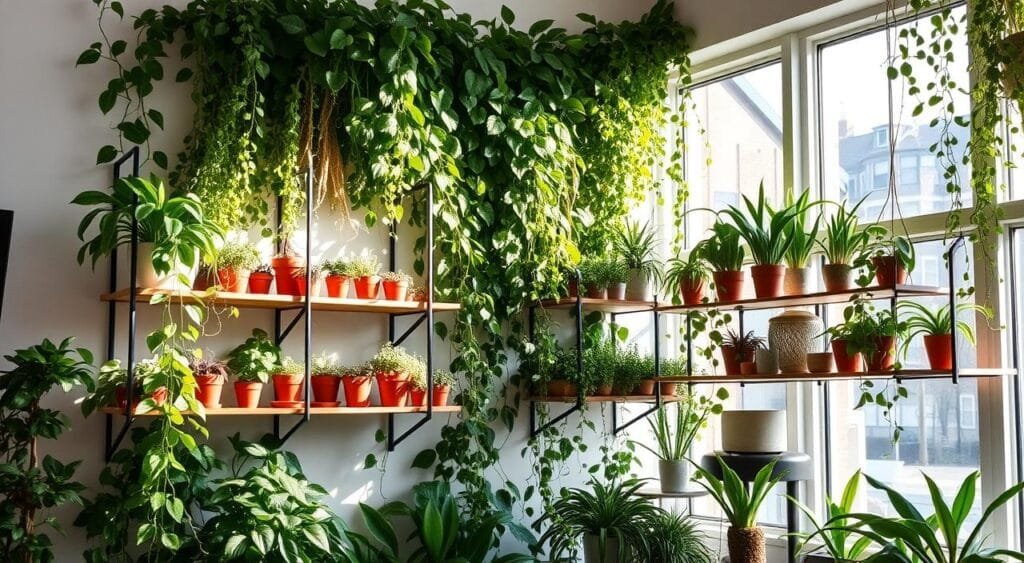
Indoor vertical gardening is great for small spaces. It turns walls into lush, green environments. Here are some creative ideas to get you started.
DIY Macramé Hanging Planters Tutorial
Macramé hanging planters add style and greenery to your apartment. You’ll need cotton rope, wooden dowels, and basic knots. Measure and cut the rope, then start knotting.
After making your hanger, hang it near a window or from the ceiling. It adds a bohemian touch and shows off your plants.
Creating a Living Wall with Pocket Planters
A living wall is a stunning room feature. You’ll need pocket planters, a backing, and plants. Arrange the planters on the backing, spacing them out.
Plant your greenery in the pockets, avoiding overcrowding. Mount your living wall on a wall or a stand. Enjoy the lush display.
Repurposed Container Vertical Gardens
Turn old containers into vertical gardens. Use pallets, crates, or plastic bottles. Clean and prepare them, then fill with soil and plants.
Stack the containers vertically, securing them to a wall or frame. This display adds character and reduces waste.
Space-Saving Corner Vertical Garden Solutions
Corners are often wasted in apartments. Use a corner vertical garden to make the most of them. Install a corner shelf or planter for a green corner.
Choose plants that fit your corner’s light. Enjoy the greenery that enhances your space.
Building Modular Wall Planter Systems for Flexible Designs
Modular wall planters let you design your vertical garden your way. You can change or grow your garden as you like. It’s a flexible way to garden.
Designing Your Custom Modular System
Think about what you want your garden to look like. Consider the size, shape, and material of the planters. Also, how they’ll look on your wall.
Key considerations include: the plants you want, the light your wall gets, and your space’s style.
Step-by-Step Construction Guide
Building your modular wall planter system starts with getting your materials ready.
Cutting and Preparing Materials
Cut your wood or materials as planned. Make sure everything fits perfectly together.
Assembly Techniques
Put the planters together using strong methods. Use the right screws or nails for your material.
Finishing and Waterproofing
Finish the planters to protect them and look good. Waterproofing keeps them safe from moisture.
Installation and Safety Considerations
Now, it’s time to put your system up. Installing it right is important for safety.
Proper Wall Mounting Techniques
Use the right anchors or screws for your wall. Make sure it’s level and strong.
Weight Distribution Tips
Spread the weight of the planters evenly. This prevents any one spot from getting too heavy.
Child and Pet Safety Measures
Make sure the planters are stable and won’t fall. Think about the height to avoid accidents.
By following these steps, you can make a beautiful and safe modular wall planter system. It will make your space better while keeping everyone safe.
Advanced Vertical Garden Techniques for Small Spaces
To take your vertical gardening to the next level, consider advanced techniques. These methods maximize space and minimize maintenance. As urban spaces shrink, innovative gardening methods are becoming more popular.
DIY Hydroponic Wall Systems
Hydroponic wall systems are a soilless solution for growing plants in small spaces. This method saves water and increases crop yields.
Materials and Components
To build a DIY hydroponic wall system, you need a few key components. These include a nutrient solution, a growing medium, and a pump system. Choosing the right materials is key for your hydroponic garden’s success.
Assembly Instructions
Assembling your hydroponic system involves setting up the nutrient delivery system. You also need to plant your chosen crops and ensure proper drainage. Attention to detail is vital during this process.
Plant Selection for Hydroponics
Not all plants are suitable for hydroponic systems. Leafy greens, herbs, and certain vegetables are popular. They adapt well and grow quickly.
Creating Self-Watering Vertical Gardens
Self-watering gardens are great for busy people or beginners. They reduce watering frequency. These systems draw water from a reservoir as needed.
Reservoir Design Principles
The reservoir is key in a self-watering garden. It should be sized right for the garden’s needs. It should also be protected from light to prevent algae growth.
Wicking System Construction
A wicking system draws water from the reservoir to the plants’ roots. You can use cotton or synthetic wicks for this.
Maintenance Requirements
While self-watering gardens need less watering, they require regular maintenance. This includes checking reservoir levels and ensuring the wicking system works right.
Vertical Succulent Gardens for Low-Maintenance Options
Vertical succulent gardens are a low-maintenance choice. Succulents store water, making them drought-tolerant and perfect for forgetful gardeners.
Seasonal Care and Maintenance of Your Vertical Garden
With the right care, your vertical garden can thrive all year. It needs attention and flexibility with the seasons.
Efficient Watering Systems and Techniques
Watering wisely is key for your garden’s health. Think about using a drip irrigation system or soaker hose. They save water and give plants the right moisture. Self-watering planters can also cut down on watering.
Seasonal Fertilizing and Soil Management
Fertilizing seasonally helps your garden grow strong. Use a balanced fertilizer when plants are growing. Switch to a bloom booster when flowers start to bloom. Check your soil often to see if it needs more or different nutrients.
Pest Control Strategies for Vertical Gardens
Keeping pests away is important for a healthy garden. Look for pests on your plants often. Use natural pest control like neem oil and insecticidal soap.
Pruning and Plant Replacement Tips
Pruning keeps your garden looking good and healthy. Remove dead plants and add new ones. Prune to keep plants bushy and prevent them from getting too long.
Conclusion: Transforming Your Small Space into a Vertical Garden Oasis
You now have the tools and inspiration to turn your small space into a lush vertical garden oasis. By adding a vertical garden or wall planter, you can enjoy gardening’s benefits, even in tight spots.
A well-designed vertical garden makes your space look better and improves health. You’ve learned how to create a thriving garden with the right materials and care. This brings life and calm to your area.
Whether you want to use your outdoor patio or add greenery indoors, this article has you covered. Start planning your vertical garden today. Experience the joy of gardening in a new way.

